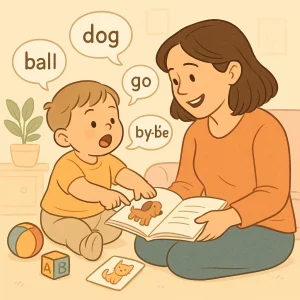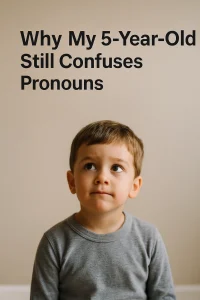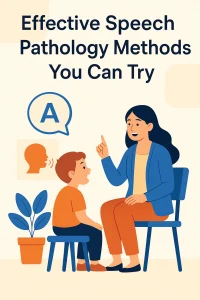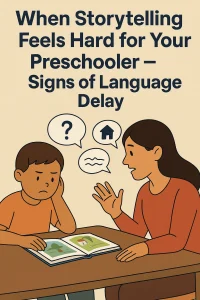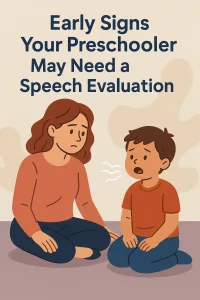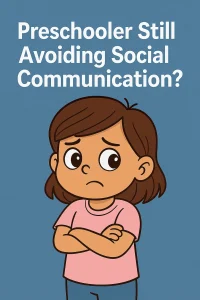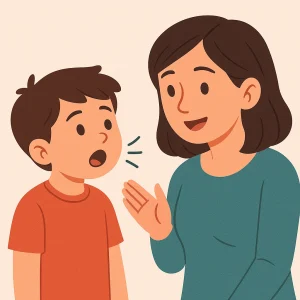Can Apraxia Go Away? Understanding the Journey
By Rajini D
Last Updated: September 12, 2024
Imagine knowing exactly what you want to say but struggling to get the words out. This is a common experience for children with Apraxia of Speech, a motor speech disorder that affects their ability to coordinate the movements needed for clear speech. It’s not that they don’t know the words—they do. The challenge lies in the brain’s communication with the muscles responsible for speaking.
Parents often wonder, “Can apraxia go away?” Understanding whether apraxia can improve or even resolve over time is a crucial concern for families navigating this journey. While there is no simple answer, this article will explore the possibilities and provide insights into the factors that influence the progress of children with AOS. We’ll delve into the importance of early intervention, consistent therapy, and supportive environments to help children make strides in their speech abilities.
What is Apraxia of Speech?
Apraxia of Speech (AOS) is a motor speech disorder that can affect children, making it challenging for them to speak clearly. Unlike other speech issues, AOS isn’t about knowing the right words or understanding language. Instead, it’s about the brain’s difficulty in coordinating the muscle movements necessary to produce those words. This disconnect can make it hard for children to say sounds, syllables, and words consistently.
Common Symptoms of Apraxia of Speech:
- Inconsistent Speech Errors: Children with AOS often struggle with saying the same word correctly every time. One day they might say a word clearly, and the next day it could come out jumbled.
- Difficulty with Speech Sounds: They may find it hard to pronounce certain sounds or combinations of sounds, leading to unclear speech.
- Unusual Stress Patterns: AOS can cause children to stress the wrong syllables or words, making their speech sound unusual or robotic.
Common Symptoms of Apraxia of Speech
| Symptom | Description |
|---|---|
| Inconsistent speech errors | Children with apraxia often have difficulty saying the same word the same way each time. For example, a child might say “cat” clearly one day and struggle to say it the next day, producing variations like “tat” or “at.” This inconsistency is a hallmark of apraxia. |
| Difficulty with sounds | This includes struggles with producing certain vowels and consonants. Children may omit, distort, or substitute sounds, making their speech unclear. For instance, they might say “wed” instead of “red” or “doggle” instead of “dog.” |
| Unusual stress patterns | Children with apraxia may place stress on the wrong syllables or words, giving their speech a robotic or sing-song quality. For example, they might say “ba-na-na” with equal stress on all syllables instead of the natural “ba-NA-na.” |
Also Read: Childhood Apraxia of Speech: Symptoms and Treatments
Can Apraxia Go Away?
A common question among parents and caregivers is, “Can apraxia go away?” The simple answer is that while apraxia doesn’t just disappear, significant improvement is possible with the right intervention and support. Apraxia of Speech (AOS) is a complex condition, and its course can vary widely from child to child.
- Improvement Through Intervention: The key to managing apraxia lies in early and consistent speech therapy. With targeted intervention, many children can make remarkable progress. Speech therapy focuses on helping children practice the correct movements of their lips, tongue, and jaw, which are necessary for clear speech. The earlier therapy begins, the better the chances for improvement, as it helps to build the necessary neural pathways for effective communication.
- Factors Affecting Improvement: Several factors influence the degree of improvement in children with apraxia. These include the severity of the condition, the child’s overall health, and their ability to focus and engage during therapy sessions. Consistent practice at home, guided by a speech therapist, also plays a crucial role in reinforcing the skills learned during sessions.
Learn more about on Do Children Outgrow Apraxia? What You Need to Know
Factors Influencing the Prognosis of Apraxia
Understanding the factors that influence the prognosis of Apraxia of Speech (AOS) can help parents and caregivers better navigate the journey of supporting their child’s speech development. Each child’s experience with apraxia is unique, and several key factors can affect how much and how quickly they improve with therapy.
- Family History: Family history can play a role in the prognosis of apraxia. If other family members have had speech disorders or similar challenges, it might provide some insight into the potential outcomes for the child. For example, if a relative experienced positive progress with therapy, it may indicate a similar path for the child, especially if the underlying causes are alike.
- Severity of Apraxia: The severity of a child’s apraxia significantly impacts their progress. Children with mild apraxia may require less intensive therapy and can see improvements more quickly. In contrast, those with severe apraxia may need more frequent and prolonged therapy sessions. The level of severity often determines the length of time it takes for a child to develop clearer speech.
- General Health and Cognitive Skills: A child’s overall health and cognitive abilities also influence their progress. Children in good general health, who are regularly well-rested and nourished, tend to respond better to therapy. Additionally, cognitive skills, such as the ability to understand and follow instructions, play a crucial role in learning and applying speech therapy techniques. Children with strong cognitive abilities often find it easier to grasp the concepts taught during sessions.
- Attention and Self-Awareness: The ability to focus during therapy sessions is critical for success. Children who can maintain attention and engage in activities are more likely to benefit from therapy. Moreover, self-awareness, or the ability to recognize and correct their own speech errors, can accelerate progress. Children who are aware of their speech challenges and work actively to improve them often make more rapid strides in their speech clarity.
Factors Affecting Apraxia Prognosis
| Factor | Description |
|---|---|
| Family History | The presence of similar speech or language issues in family members can influence the prognosis. If other family members have experienced and managed apraxia, it might provide insight into potential outcomes and response to therapy for the child. Genetics can play a role in speech and language development. |
| Severity of Apraxia | The severity of the apraxia, ranging from mild to severe, significantly affects the child’s progress. Children with mild apraxia may require less intensive intervention and tend to show quicker improvements. In contrast, those with severe apraxia may need more extensive therapy over a longer period to achieve noticeable progress. |
| General Health | The child’s overall health status, including physical conditions such as frequent ear infections or respiratory issues, can impact their ability to engage consistently in therapy. Children in good general health are typically more “available” for learning and therapy, leading to better outcomes. |
| Cognitive Skills | A child’s cognitive abilities, including understanding, memory, and problem-solving skills, are crucial for effective participation in therapy. Children who can easily understand and follow instructions often make better use of therapy sessions, learning and applying new speech patterns more effectively. |
| Attention and Self-Awareness | The ability of the child to maintain focus during therapy sessions is vital for progress. Additionally, self-awareness—being able to recognize and correct their own speech errors—can significantly enhance the effectiveness of therapy. Children who are attentive and self-aware tend to respond better and make more consistent improvements. |
Know more: Speech Therapy for Developmental Apraxia: How It Can Help Your Child
Importance of Early and Frequent Intervention
Early Diagnosis and Intervention
When it comes to Apraxia of Speech (AOS), early diagnosis and intervention are crucial. Starting therapy early, ideally by age 3, can make a significant difference in a child’s ability to improve their speech. Early intervention helps to catch speech difficulties before they become ingrained patterns, making it easier to address and correct them. Children’s brains are highly adaptable at a young age, which means they can learn new ways to communicate more effectively.
Frequency and Consistency of Therapy
Just as early intervention is essential, so too is the frequency and consistency of therapy. Regular speech therapy sessions provide continuous practice and reinforcement, which are key to making progress. Consistency helps children internalize the techniques they learn and apply them in everyday communication.
Frequent sessions allow for more intensive practice, which can accelerate progress. It also enables therapists to adjust strategies based on the child’s evolving needs, ensuring that the therapy remains effective. For many children, this means attending therapy multiple times a week, with additional practice at home.
The Role of Parents and Caregivers
Parental Involvement
Parents and caregivers play a pivotal role in the progress of children with Apraxia of Speech (AOS). Active participation in therapy sessions and home exercises can make a substantial difference in a child’s speech development. Being involved means more than just attending therapy sessions; it includes understanding the techniques used, practicing them consistently at home, and communicating regularly with the speech therapist to track progress and adjust strategies as needed.
Engaging in home exercises reinforces what is learned during therapy sessions. This consistent practice helps children build muscle memory for correct speech patterns and encourages them to apply these skills in everyday situations. For example, practicing sounds, words, or phrases through games or daily routines can make the learning process fun and natural.
Support and Motivation
A supportive and encouraging environment is crucial for motivating children with AOS. Children who feel supported by their families are more likely to engage positively with therapy and persist through challenges. Parents and caregivers can create a nurturing atmosphere by celebrating small victories, providing constructive feedback, and encouraging their children to communicate without fear of making mistakes.
Motivation is a key factor in the success of speech therapy. Children who are motivated to improve their speech are more likely to participate actively in therapy and practice diligently. Parents can foster this motivation by setting achievable goals, offering praise for efforts and improvements, and making therapy a positive and rewarding experience.
Realistic Expectations and Long-Term Outlook
No Absolute Prognosis
Every child’s journey with Apraxia of Speech (AOS) is unique, making it essential for parents and caregivers to have realistic expectations. Unlike some medical conditions with clear-cut outcomes, the prognosis for children with apraxia can vary widely. Some children may experience significant improvements in their speech clarity, while others may continue to face challenges. This variability is due to factors such as the severity of the condition, the effectiveness of therapy, and individual differences in learning and adaptation.
It’s important to understand that predicting the exact outcome for a child with apraxia is challenging. While some children may achieve near-normal speech, others may need ongoing support. Parents should focus on the progress their child makes, rather than comparing them to others. Celebrating small victories and understanding that progress may come in different forms can help manage expectations and keep motivation high.
Promising Research and Techniques
The field of speech therapy is continually evolving, with new research and techniques offering hope for children with apraxia. Advances in therapy methods, such as the use of technology and specialized speech therapy programs, have shown promising results. These developments allow therapists to tailor interventions more precisely to each child’s needs, increasing the chances of positive outcomes.
Conclusio
In wrapping up, addressing apraxia demands both time and commitment, but with early and consistent intervention, children can make remarkable strides. While the condition won’t vanish overnight, proper guidance can foster significant improvements. Parents and caregivers are vital, providing support that is both nurturing and involved. It’s essential to maintain realistic goals and acknowledge the unique pace at which each child may progress. At Wellness Hub, we provide targeted speech therapy tailored to each child’s needs, aiding them in realizing their communicative potential. If your child is facing challenges with apraxia, remember, help is just a click away at our Wellness Hub website. Together, we can navigate this journey toward effective communication.
Frequently Asked Questions:
1. What is Apraxia of Speech (AOS)?
Apraxia of Speech (AOS) is a motor speech disorder where children have difficulty coordinating the muscle movements needed to speak clearly, even though they know what they want to say.
2. Can Apraxia of Speech go away on its own?
Apraxia of Speech doesn’t typically go away on its own. However, with early and consistent speech therapy, children can make significant improvements in their speech clarity.
3. What are the common symptoms of Apraxia of Speech?
Common symptoms include inconsistent speech errors, difficulty pronouncing certain sounds, and unusual stress patterns in speech.
4. How does early intervention help with Apraxia of Speech?
Early intervention can help address speech challenges before they become ingrained habits, making it easier for children to learn correct speech patterns and improve over time.
5. What factors influence the prognosis of Apraxia of Speech?
The prognosis can be influenced by factors such as family history, the severity of apraxia, the child’s general health and cognitive skills, and their ability to focus during therapy.
6. How often should a child with Apraxia of Speech attend therapy?
Frequent and consistent therapy sessions, often multiple times a week, are recommended to help reinforce learning and support progress.
7. What role do parents and caregivers play in treating Apraxia of Speech?
Parents and caregivers are crucial in supporting their child’s progress by participating in therapy, practicing exercises at home, and providing a supportive environment.
8. Are there promising treatments for Apraxia of Speech?
Yes, there are effective treatments and techniques, such as the Kaufman Speech to Language Protocol, that have shown promising results in improving speech in children with apraxia.
9. How can I help my child with Apraxia of Speech at home?
You can help by practicing speech exercises, creating a supportive and encouraging environment, and staying in close communication with your child’s speech therapist.
10. Where can I find specialized speech therapy services for Apraxia of Speech?
Specialized services are available at Wellness Hub, where experienced therapists provide personalized treatment plans to help children with apraxia improve their communication skills.
About the Author:
Rajini Darugupally
M.Sc., Speech-Language Pathologist (9+ years of experience)
Rajini is a passionate and dedicated Speech-Language Pathologist with over 9+ years of experience, specializing in both developmental speech and language disorders in children and rehabilitation in adults. Driven by a desire to empower each individual to find their voice, Rajini brings a wealth of experience and a warm, genuine approach to therapy. Currently, at Wellness Hub, she thrives in a team environment that values innovation, compassion, and achieving results for their clients.
Book your Free Consultation Today
Parent/Caregiver Info:
Client’s Details:
* Error Message


